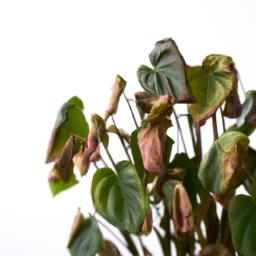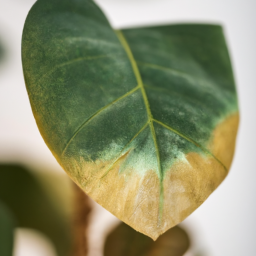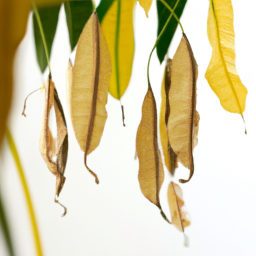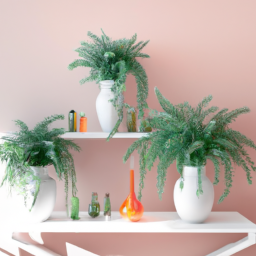
Have you ever noticed your indoor plants starting to develop brown spots on their leaves? It can be concerning to see your greenery looking less than healthy, but don’t worry, you’re not alone. Many plant owners experience this issue, and there are several reasons why indoor plants leaves turn brown. In this blog post, we’ll explore some common causes of browning leaves in indoor plants and provide tips on how to prevent and treat this common problem. So, if you’re wondering why your beloved houseplants are showing signs of distress, keep reading to learn more about how to keep them happy and thriving.
Common Causes of Indoor Plants Leaves Turning Brown
1. Lack of Proper Watering
One of the most common reasons why indoor plant leaves turn brown is due to a lack of proper watering. Plants need water to survive, and when they don’t receive enough, their leaves can start to dry out and turn brown. It’s important to water your plants regularly, but be careful not to overwater them either. Overwatering can lead to root rot, which can also cause the leaves to turn brown.
To ensure your plants are getting the right amount of water, it’s important to check the soil moisture regularly. Stick your finger into the soil about an inch deep – if it feels dry, it’s time to water. If it feels wet, wait a few more days before watering again. Different plants have different watering needs, so make sure to research the specific requirements for each of your indoor plants.
In addition to regular watering, it’s also important to make sure your plants are getting enough humidity. Some plants, especially tropical ones, thrive in humid environments. If the air in your home is too dry, consider using a humidifier or placing a tray of water near your plants to increase the humidity level.
2. Lack of Proper Lighting
Another common reason why indoor plant leaves turn brown is due to a lack of proper lighting. Plants need light to photosynthesize and grow, so if they’re not getting enough light, their leaves can start to brown and wilt. Different plants have different light requirements – some prefer bright, indirect light, while others can tolerate low light conditions.
To ensure your plants are getting the right amount of light, place them near a window where they can receive natural sunlight. If your home doesn’t have enough natural light, consider using grow lights to supplement the light your plants are receiving. Make sure to rotate your plants regularly so that all sides receive equal light exposure.
In addition to the amount of light, it’s also important to consider the quality of light your plants are receiving. Direct sunlight can be too harsh for some plants, leading to sunburn and browning of the leaves. Make sure to provide shade or use a sheer curtain to filter the light if necessary.
3. Lack of Proper Nutrients
Lastly, indoor plant leaves can turn brown due to a lack of proper nutrients. Plants need a variety of nutrients, such as nitrogen, phosphorus, and potassium, to thrive and grow. If your plants are not receiving enough nutrients, their leaves can start to show signs of deficiency, including browning and yellowing.
To ensure your plants are getting the right nutrients, consider using a balanced fertilizer specifically designed for indoor plants. Follow the instructions on the fertilizer package carefully, as over-fertilizing can also lead to browning of the leaves. In addition to fertilizer, consider repotting your plants every year or so to refresh the soil and provide them with fresh nutrients.
In conclusion, there are several common reasons why indoor plant leaves turn brown, including lack of proper watering, lighting, and nutrients. By addressing these issues and providing your plants with the care they need, you can help prevent browning of the leaves and keep your indoor plants healthy and thriving.

How to Prevent Indoor Plants Leaves from Turning Brown
Understanding the Causes of Brown Leaves
When it comes to indoor plants, brown leaves can be a common issue that many plant owners face. There are several reasons why indoor plants leaves turn brown, and it’s important to understand these causes in order to prevent it from happening in the future.
One of the main reasons why indoor plants leaves turn brown is due to overwatering. When plants are overwatered, their roots can become waterlogged, leading to a lack of oxygen and nutrients being able to reach the leaves. This can cause the leaves to turn brown and eventually die off. It’s important to water your plants only when they need it and to ensure that the soil has proper drainage to prevent overwatering.
Another common cause of brown leaves on indoor plants is underwatering. When plants don’t receive enough water, their leaves can start to dry out and turn brown. It’s important to water your plants regularly and to ensure that they are getting enough water to stay healthy and hydrated.
In addition to watering issues, brown leaves can also be caused by environmental factors such as low humidity, poor lighting, and temperature fluctuations. Indoor plants thrive in specific conditions, and if these conditions are not met, it can lead to stress on the plant and cause their leaves to turn brown. It’s important to provide your plants with the right amount of light, humidity, and temperature to ensure that they stay healthy and vibrant.
Tips for Preventing Brown Leaves
Now that you understand the causes of brown leaves on indoor plants, here are some tips for preventing it from happening in the future:
1. Water your plants properly: Make sure to water your plants only when they need it and ensure that the soil has proper drainage to prevent overwatering.
2. Provide the right environment: Make sure to provide your plants with the right amount of light, humidity, and temperature to ensure that they thrive and stay healthy.
3. Monitor your plants: Keep an eye on your plants and check for any signs of stress or damage. If you notice any brown leaves, take action immediately to prevent further damage.
By following these tips and being proactive in caring for your indoor plants, you can prevent brown leaves and keep your plants healthy and vibrant. Remember to always provide your plants with the love and attention they need to thrive in your home.

Why Indoor Plants Leaves Turn Brown
Indoor plants can bring life and beauty to any space, but sometimes their leaves can turn brown, which can be a cause for concern. There are several reasons why indoor plants’ leaves may turn brown, and it’s important to understand these causes in order to properly care for your plants.
1. Overwatering
One of the most common reasons why indoor plants’ leaves turn brown is overwatering. When plants are watered too frequently or if they are sitting in waterlogged soil, their roots can become waterlogged and suffocated. This can lead to root rot, which in turn can cause the plant’s leaves to turn brown and wilt.
To prevent overwatering, make sure to allow the soil to dry out between waterings. You can also use a moisture meter to check the soil’s moisture levels before watering. Additionally, make sure to use well-draining soil and pots with drainage holes to prevent water from accumulating at the bottom of the pot.
If you suspect that your plant is suffering from overwatering, you can try repotting it in fresh, well-draining soil and cutting back on watering until the plant shows signs of recovery.
2. Low Humidity
Another common reason why indoor plants’ leaves turn brown is low humidity. Many indoor plants, especially tropical plants, thrive in high humidity environments. When the air in your home is too dry, plants may not be able to absorb enough moisture through their leaves, which can cause their leaves to turn brown and crispy.
To increase humidity around your plants, you can mist them regularly, place a humidifier near your plants, or group your plants together to create a microclimate with higher humidity. You can also place a tray of water near your plants to help increase humidity levels.
If your plant’s leaves have already turned brown due to low humidity, you can trim off the browned areas and take steps to increase humidity levels to prevent further damage.
3. Nutrient Deficiency
Indoor plants require a balance of nutrients to thrive, and a deficiency in essential nutrients can cause their leaves to turn brown. Common nutrient deficiencies that can cause brown leaves include nitrogen, potassium, and magnesium deficiencies.
To prevent nutrient deficiencies, make sure to fertilize your plants regularly with a balanced fertilizer. You can also use a plant food specifically formulated for indoor plants to ensure that they are receiving all the nutrients they need to stay healthy.
If you suspect that your plant is suffering from a nutrient deficiency, you can try fertilizing it with a balanced fertilizer and monitoring its progress. If the plant does not show signs of improvement, you may need to consult a plant specialist for further guidance.
In a Nutshell
Have you ever noticed your indoor plant’s leaves turning brown and wondered why it’s happening? There are a few common reasons for this issue, and understanding them can help you better care for your plants. One common cause of brown leaves is overwatering. When plants receive too much water, their roots can become waterlogged, leading to a lack of oxygen and nutrient uptake. This can cause the leaves to turn brown as the plant struggles to absorb the water it needs.
Another common reason for brown leaves is underwatering. If a plant doesn’t receive enough water, its leaves can become dry and crispy, eventually turning brown. In some cases, brown leaves can also be a sign of nutrient deficiencies or pests. Checking the soil moisture, adjusting your watering schedule, and inspecting your plant for signs of pests can help you address the issue and keep your indoor plants healthy and thriving. Remember, each plant has its own unique needs, so it’s important to research the specific care requirements for each plant in your collection.
Here are the top questions that we were asked:
Q1: Why do indoor plant leaves turn brown?
Indoor plant leaves can turn brown due to a variety of reasons, including overwatering, underwatering, lack of humidity, too much direct sunlight, or even the presence of pests or diseases.
Q2: How can I prevent my indoor plant leaves from turning brown?
To prevent your indoor plant leaves from turning brown, make sure to water your plants properly, provide adequate humidity, place them in the right amount of sunlight, regularly inspect for pests, and ensure good air circulation around the plant.
Q3: Can brown leaves on indoor plants be saved?
In some cases, brown leaves on indoor plants can be saved by trimming off the affected areas, adjusting the plant’s care routine, and providing the necessary conditions for new growth. However, if the damage is extensive, it may be best to remove the affected leaves.
Q4: How often should I water my indoor plants to prevent brown leaves?
The frequency of watering indoor plants varies depending on the type of plant, the size of the pot, the season, and the environment. It’s important to check the soil moisture level before watering to prevent overwatering, which can lead to brown leaves.
Q5: Are there specific indoor plants that are more prone to getting brown leaves?
Some indoor plants are more sensitive to environmental changes and are more prone to developing brown leaves. Examples include Fiddle Leaf Figs, Peace Lilies, and Spider Plants. It’s important to research the specific care requirements of your indoor plants to prevent brown leaves.
Dr. Olivia Green is a botanist with over two decades of experience in indoor plant cultivation. She holds a Ph.D. in Plant Biology and has dedicated her career to researching plant behavior in controlled environments. Dr. Green is passionate about helping plant enthusiasts master the art of indoor gardening through her extensive knowledge and practical insights.


